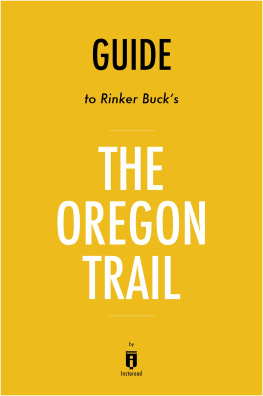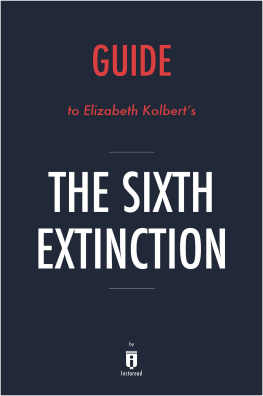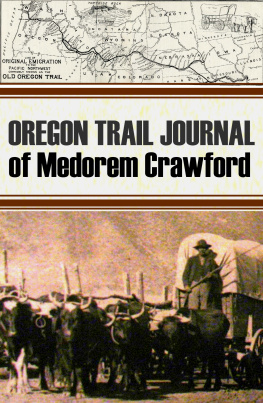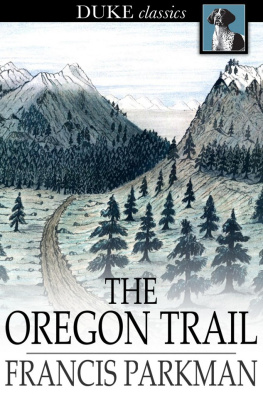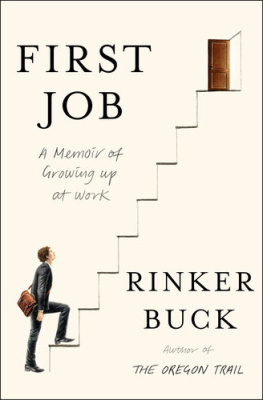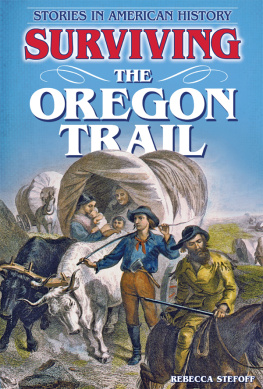Guide to
Rinker Bucks
The Oregon Trail
The New American Journey
by
Instaread
Please Note
This is a companion to the original book.
Copyright 2015 by Instaread. All rights reserved worldwide. No part of this publication may be reproduced or transmitted in any form without the prior written consent of the publisher.
Limit of Liability/Disclaimer of Warranty: The publisher and author make no representations or warranties with respect to the accuracy or completeness of these contents and disclaim all warranties such as warranties of fitness for a particular purpose. The author or publisher is not liable for any damages whatsoever. The fact that an individual or organization is referred to in this document as a citation or source of information does not imply that the author or publisher endorses the information that the individual or organization provided. This concise companion is unofficial and is not authorized, approved, licensed, or endorsed by the original books author or publisher.
Table of Contents
Summary
Rinker Bucks The Oregon Trail: A New American Journey chronicles Rinker and his brothers experiences reliving the journey taken by the original nineteenth-century travelers of the Oregon Trail. At the same time, the author goes through his own mental and emotional journey and comes to grips with a variety of issues, such as being a pack rat and his relationship with his father.
The inspiration for Rinkers journey began when he walked along old Oregon Trail ruts in Kansas while working on a story as a journalist. He saw nearby exhibits about the trail and spoke with the site administrator about the Oregon Trail. He was captivated by details the man shared.
That experience, coupled with a childhood experience when his father took Rinker and his siblings on a wagon trip through the Northeast, inspired Rinker to take the Oregon Trail on his own. His brother, Nick, insisted on joining. Since Nick had an encyclopedic knowledge of wagons, mules, and other handy skills for the journey, Rinker agreed. Nick also brought his dog, Olive Oyl, on the trip. Appeasing Rinkers passions of travel and history, the two brothers would follow one of the many versions of the original trail in a traditional mule-drawn covered wagon, just like the historic pioneers.
To prepare, Rinker, an avid reader, read a number of books about the Oregon Trail and related subjects, such as mules and covered wagons. Rinker made calls to secure the supplies he would need, particularly a reliable team of mules, an authentic nineteenth-century covered wagon, and a Trail Pup, a smaller wagon that could carry additional supplies. The Trail Pup could also be unhooked from the main wagon and drawn by the mules for shorter trips. Rinkers team of mules included Jake, Bute, and Beck, and each had its own personality. Nick noticed some problems with the wagon when he first saw it, but chose not to say anything.
Preparations, such as gathering certain supplies and making alterations to the wagon took several days. It also caused a few disputes between Rinker and Nick, such as when Rinker tried to bring along too much unnecessary gear. Finally, the brothers were off on their journey in June of 2011.
The brothers journey began in Kansas on US Highway 36. Life on the trail was difficult. It included having to stay awake while they rode through the countryside and keeping up with both the work involved and their set pace of twenty miles per day. After the very first day, Rinker already sensed a change in himself, as he rid himself of the needless possessions he smuggled onto the wagon even though Nick had told him not to bring them.
The brothers were also adapting to the personalities of their mules. Bute was hardworking but less athletic than the other two. Beck was unpredictable and shied away from many different things by leaping sideways and pushing the other mules. Jake was the star, the leader, and the calmest among them. Early on, Rinker worried that he hastily bought a poor team of mules, but that opinion would change over time.
Along the trail, the brothers met some people who were less than hospitable, such as those who drove their vehicles too close to the wagon and mules, but, for the most part, people loved seeing the covered wagon passing through their towns. People often offered gifts of food or supplies, invited them in for a shower, or offered tips to navigate the trail. Some of these people would become known to the brothers as their trail family, mirroring the sense of camaraderie felt by many pioneers on the original Oregon Trail.
At one point on their journey through Kansas, the brothers approached a bridge with an expansion joint that spooked Beck, who started to throw a fit. With some coaxing from the Buck brothers, the mules did make it over the joint, and they finished crossing the bridge. The incident reminded Rinker of a similar wagon bridge crossing with his father when he was a child that was one of several memories that would fill Rinkers mind on their travels. Another memory later on was inspired by a man they met on the trail that vividly reminded Rinker of his father, offering Rinker an emotional reckoning of that relationship.
After crossing the Nebraska state line, the Buck brothers found their first marker for the Oregon Trail. Much like the original pioneers, the brothers dealt with torrential rains throughout their voyage that caused their own set of headaches, such as losing their lantern and artificial light for nighttime. In one particularly difficult moment, Rinker became emotional and lamented Nicks decision to leave him for several weeks to perform in a play. Rinker felt guilty and embarrassed about the display of emotion later. In the end, Nick decided to remain with Rinker for the duration of the trip, saying that the brothers needed each other for the journey.
When the brothers reached the Platte River, which was remote and located along undeveloped countryside, they enjoyed long stretches along the dirt roads that followed the river that were remnants of the original series of pathways taken by the pioneers on the Oregon Trail. Beck tried to run away, but Nick handled him expertly.
The brothers faced other difficulties along the way, such as dangerously thin paths through bluffs and steep climbs amid high terrain that they sometimes chose to take over other options. These more treacherous pathways caused issues with the mules, wagon, or the Trail Pup. At one point, problems arose with their wagons wheels, which had begun to rot. Nick knew this, but did not tell Rinker, who was ashamed to have paid so much for a wagon with rotting wheels. Not long after, the Trail Pup tipped over while they were riding a hill at an angle and broke in a few places, but Nick and Rinker were able to repair it.
The brothers passed by many natural landmarks, such as Chimney Rock, the Black Hills, California Hill, and Independence Rock, as well as over and through the Rocky Mountains. They passed through Wyoming and stopped at Fort Fetterman for the Fourth of July. The mules jumped the cattle guard, and Nick had to chase them down in his pickup truck. The brothers fought because Rinker felt that Nick was living like a slob. Upset, Nick took off in the truck but slammed into a pole and dented the bumper and tailgate. They made up and continued on their journey.
Mormons were an integral part of the story of the nineteenth-century trail, as they were at the center of both controversy and business on the trail. In Wyoming, the brothers interacted with a Mormon elder and later a Mormon couple who helped them navigate a tough part of the trail, Rocky Ridge.
The Buck brothers were lost for part of their journey, ending up on a ranch with a couple who initially accused them of trespassing. The couples dog attacked and injured Olive Oyl. They had a few incidents where they accidentally left supplies behind that Rinker attributed to hypoxia, a hazy forgetfulness that can set in at high altitudes. Their Trail Pup shattered at one point, forty miles away from the nearest town, so they had to temporarily leave it behind. After it was repaired, it broke again not long after. They also began traversing the deserts of Wyoming and could camp only when they found a water source that day.
Next page
